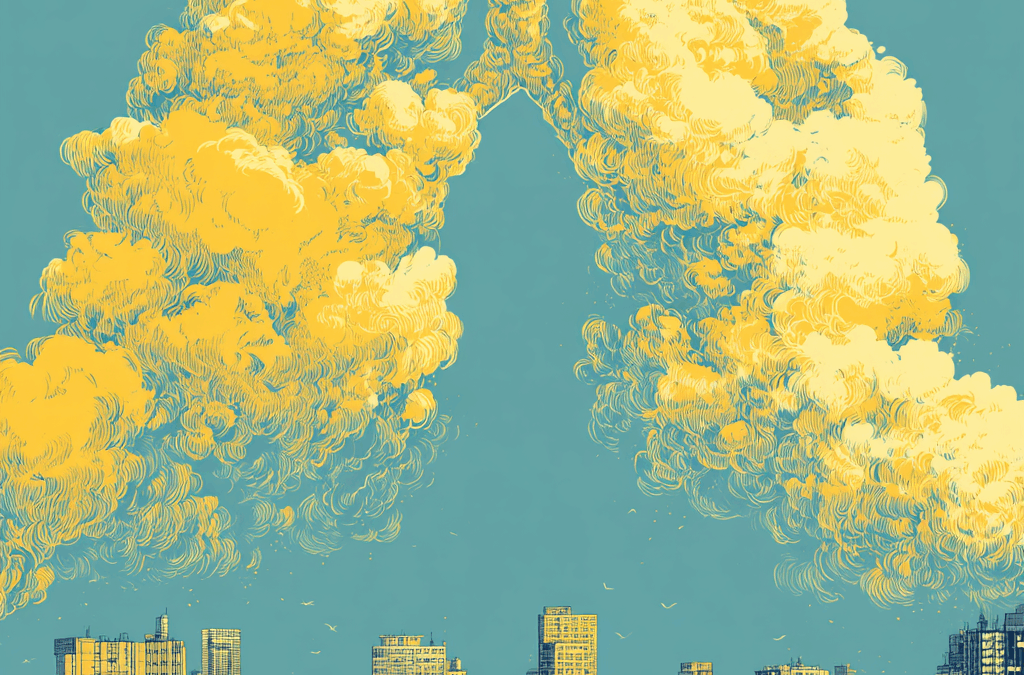
Air Quality, Pollution, and Protecting Your Lungs – Ch 10 – Breathe to Heal: How Nutrition and Lifestyle Can Save Your Lungs
Chapter 10: The Environment Factor — Air Quality, Pollution, and Protecting Your Lungs in a Modern World
Breathe to Heal: How Nutrition and Lifestyle Can Save Your Lungs
“You can’t choose the world you breathe in — but you can choose how you breathe through it.”
Every inhale connects you to the environment around you — for better or worse.
The average adult breathes about 20,000 times a day, drawing in roughly 11,000 liters of air.
That air isn’t just oxygen. It’s a mix of invisible elements — some healing, others harmful.
In today’s world, we face more environmental threats to lung health than at any other point in history.
From urban smog and wildfire smoke to indoor pollutants and microplastics, the respiratory system is constantly challenged.
But the good news is powerful: you have the ability to reduce your exposure, strengthen your defenses, and even reverse environmental damage — all through awareness, nutrition, and lifestyle.
☁️ 1. The Modern Air Crisis
According to the World Health Organization (WHO), over 90% of the global population lives in areas where air quality exceeds safe limits.
Air pollution now causes more than 7 million premature deaths each year — more than malaria, HIV, and car accidents combined.
The most dangerous pollutants include:
-
PM2.5: Microscopic particles from cars, industry, and fires that penetrate deep into the lungs.
-
Nitrogen dioxide (NO₂): Emitted by vehicles and gas stoves.
-
Ozone (O₃): A reactive gas that irritates lung tissue.
-
Volatile organic compounds (VOCs): Released by paints, cleaning products, and plastics.
These toxins trigger inflammation, oxidative stress, and cell damage — especially in people with asthma, COPD, or cardiovascular disease.
🏙️ 2. Outdoor Air: Invisible But Impactful
Whether you live in a city or rural area, outdoor air quality affects your health daily.
Urban dwellers are exposed to exhaust, ozone, and particulate matter, while rural residents may face pollen, dust, and agricultural chemicals.
Simple ways to reduce exposure:
-
Check local air quality indexes (AQI) using apps like AirNow or IQAir. Avoid outdoor exercise when AQI > 100.
-
Choose early morning walks when air is cooler and cleaner.
-
Use N95 masks during smog, wildfires, or heavy traffic exposure.
-
Plant greenery around your home: trees and houseplants naturally filter particulates.
-
Avoid idling vehicles or jogging near busy roads.
Science says:
A Harvard T.H. Chan School of Public Health (2024) study found that reducing daily PM2.5 exposure by just 10 µg/m³ cut mortality risk by 7% — a massive improvement achieved through simple behavioral changes.
🏠 3. Indoor Air: The Hidden Threat
Most people spend 90% of their lives indoors — yet indoor air can be 2 to 5 times more polluted than outdoor air.
Common indoor pollutants include:
-
Mold spores and dust mites (from humidity and poor ventilation)
-
Synthetic fragrances in candles, air fresheners, and detergents
-
Cleaning chemicals that release formaldehyde and VOCs
-
Gas stoves that emit nitrogen dioxide
-
Tobacco smoke and secondhand vapor
🧹 Steps to improve indoor air:
-
Ventilate daily. Open windows or use fans to circulate fresh air.
-
Use HEPA air purifiers — especially in bedrooms and living spaces.
-
Avoid synthetic fragrances. Choose essential oils or fragrance-free cleaners.
-
Control humidity (40–50%) to prevent mold growth.
-
Use nontoxic materials: natural cleaning agents like vinegar, lemon, or baking soda.
Pro tip: The NASA Clean Air Study identified peace lilies, spider plants, and snake plants as effective natural filters for VOCs and carbon monoxide.
🔥 4. Wildfire Smoke and Climate Challenges
In recent years, wildfire smoke has become one of the most severe threats to respiratory health — even for people hundreds of miles away from the flames.
Smoke contains ultra-fine particles and carcinogens that can linger in the air for weeks.
Protective measures:
-
Keep windows closed and use an indoor air purifier with activated carbon.
-
Wear a fit-tested N95 mask outdoors.
-
Avoid exercising or burning candles during smoke events.
-
Stay hydrated — water helps flush out toxins absorbed via inhalation.
-
Eat anti-inflammatory foods (turmeric, berries, green vegetables) to counter oxidative stress.
A 2023 Stanford Medicine report found that wildfire smoke exposure can age lung tissue by up to 10 years in frequent exposure zones — but that recovery is possible through antioxidant-rich diets and proper filtration.
🌿 5. The Role of Nutrition in Pollution Defense
You can’t stop breathing polluted air — but you can make your lungs more resilient to it.
The right nutrients strengthen your natural detox pathways and repair oxidative damage.
Top protective nutrients:
-
Vitamin C: Reduces airway inflammation and oxidative stress.
-
Vitamin E: Stabilizes cell membranes damaged by free radicals.
-
Sulforaphane (from broccoli sprouts): Activates detox enzymes that neutralize pollutants.
-
Omega-3 fatty acids: Decrease inflammatory cytokines caused by pollution exposure.
-
Flavonoids: Found in berries, onions, and apples — they strengthen lung capillaries.
Science says:
A British Medical Journal (2022) study showed that individuals with high fruit and vegetable intake had 30% better lung resilience during pollution spikes than those on low-plant diets.
🧴 6. The Chemical Load: Toxins in Everyday Products
It’s not just air pollution that harms the lungs — everyday household and beauty products also release harmful vapors.
Common offenders:
-
Aerosol sprays and disinfectants
-
Nail polish remover (acetone)
-
Perfumes and scented candles (phthalates, benzene)
-
Plastic containers (BPA, PVC)
Swap for cleaner options:
-
Use natural or unscented products.
-
Store food in glass, not plastic.
-
Use beeswax candles or diffusers instead of synthetic fragrances.
-
Choose non-toxic paints and cleaning supplies.
Over time, lowering your chemical load can reduce respiratory irritation, headaches, and fatigue.
🌬️ 7. Air Purification: Creating a Safe Breathing Zone
If the outside world is beyond your control, make your indoor environment your sanctuary.
How to purify your air naturally and effectively:
-
HEPA filters: Capture 99.97% of particles ≥0.3 microns (dust, pollen, smoke).
-
Activated carbon filters: Remove gases and odors.
-
Salt lamps or ionizers: Can help neutralize airborne particles.
-
Houseplants: Aloe vera, bamboo palm, and peace lilies naturally clean the air.
-
Charcoal bags: Passive air purifiers that absorb VOCs and moisture.
Tip: Replace air filters every 3 months — more often if you live in high-pollution zones.
🌈 8. Building Your “Clean Air Ritual”
Here’s how to turn environmental protection into a daily, effortless practice:
Morning:
-
Open windows briefly to flush out stale air.
-
Drink lemon water to hydrate and flush the respiratory tract.
-
Mist indoor plants to release oxygen and humidity.
Afternoon:
-
Diffuse eucalyptus or peppermint oil (supports airways and focus).
-
Check AQI before going outdoors.
Evening:
-
Run your air purifier before bed.
-
Avoid candles, sprays, or strong detergents.
-
Do 10 minutes of deep breathing to clear residual CO₂ and relax the lungs.
Your home can be your greatest defense — a clean, oxygen-rich sanctuary for recovery.
🔬 9. The Future of Air and Lung Health
The intersection of climate change, urbanization, and industrialization makes clean air the next frontier of public health.
New technologies — like portable filtration systems, smart sensors, and air-quality wearables — are helping individuals monitor and protect their respiratory health in real time.
But the most powerful solution still lies within reach:
Supporting your body’s own resilience through mindful breathing, plant-rich nutrition, movement, and clean living.
The lungs are not passive victims of pollution — they are adaptive organs that can recover, rebuild, and thrive when given the right conditions.
🌤️ 10. A Breath of Empowerment
You may not control the air outside — but you can master the way your body interacts with it.
By making conscious choices about your environment, nutrition, and breathing, you turn every inhale into an act of protection.
Clean air begins within.
🔑 Key Takeaway
Air quality is one of the greatest health challenges of our era — but your lungs are powerful, regenerative, and responsive.
Through awareness, clean habits, and mindful breathing, you can transform even a polluted world into an opportunity for healing and renewal.




